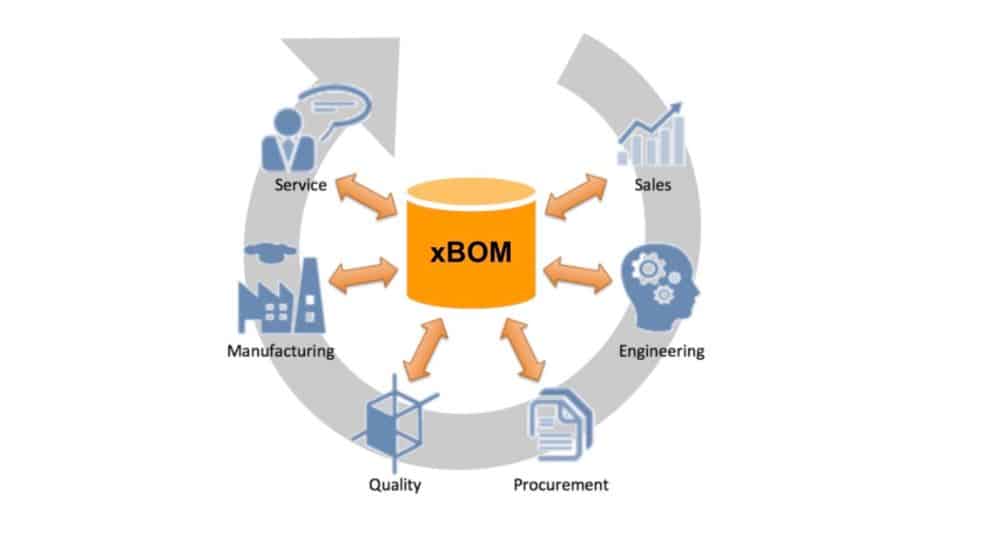
The question of BOM Types comes up quite often and it can be super confusing for many people even those directly involved in the manufacturing and purchasing process.
You can quickly be overwhelmed by the number of buzzwords and names – EBOM, MBOM, SBOM, XBOM, etc. So, where to start?
First let’s separate two categories…
- BOM types and formats
- BOM types in different lifecycle stages.
Earlier this week I wrote a blog post sharing a detailed look into different BOM types and formats. If you haven’t had a chance to check it out yet click on the link below…
Bill of Materials Types, Formats, and Examples.
Today, I want to talk about category #2 – different lifecycle stages. A typical product life cycle goes from requirements to design, engineering, planning, manufacturing, support and maintenance. Depending on the complexity of the product and manufacturing process these stages can be defined differently and use different software, but the principles remain the same.

Each product lifecycle stage requires its own representation of the data. What is needed for engineers is usually different from what is required from the people in production planning or procurement.
Sometimes, it can be the same data presented differently. But very often, it is also a different set of data. While engineers are working on a new product release, customers need maintenance work done with the previous product release.
Here are typical BOM (types) that can be used in relation to product lifecycle stages and what you would expect to see there.
Design BOM
Design BOM (As-Designed). It is usually an assembly-component structure with documents coming from the CAD system. It reflects the data and the structure of how it is seen by engineers at the design phase. It is heavily focused on how a product is designed, its topology and relationships. The data usually lacks specific manufacturing information.
Engineering BOM (EBOM)
This BOM is usually an extension of design information and it contains all information about how the product is engineered. It contains various pieces of information (not only design) and it must be a complete representation of everything that is needed to build the product. If something is not there it might lead to problems in the future.
Planning BOM
This is a BOM that is used for planning purposes. It reflects manufacturing and procurement information and is used by organizations outside of engineering for planning purposes.
Manufacturing BOM (MBOM)
MBOM represents the data that is needed to perform product assembly. It is also the BOM that is used heavily by systems like ERP and others in production planning, MES and related systems.
SBOM
Supply Chain BOM sometimes refers to the data that is shared with suppliers and contractors. It includes a subset of information that is needed for suppliers and may lack other information.
Service / Maintenance BOM
This is a subset of an entire BOM, which is available for maintenance organization. Typically this BOM only includes information that is needed for service and maintenance tasks. It might lack specific details about engineering, production and supply chain.
BOM Type Rationalization
As you can see manufacturing demands a complex data management system effort to manage all the information that goes into the design and creation of a product. The names above only reflect the type of information but don’t reflect the way the data is managed.
OpenBOM can help you not only rationalize the way data is managed but also optimize the way that data is accessed.
Conclusion
BOM types can be overwhelming, but if you follow product lifecycle stages you’ll see a simple logic behind it all.
If you follow the lifecycle and the data that is needed for the product life cycle then you’ll always figure out the right BOM name and what information is needed.
The question of what system (or systems) can manage these BOMs together is a subject for another blog article.
At OpenBOM, we provide a flexible infrastructure to manage different types of BOMs and share information about BOM and related data with different stakeholders across the product life cycle. If you have any questions feel free to reach out to us and we’ll be happy to help.
REGISTER FOR FREE to OpenBOM and explore the ways we can help you.
Best, Oleg
Join our newsletter to receive a weekly portion of news, articles, and tips about OpenBOM and our community.









